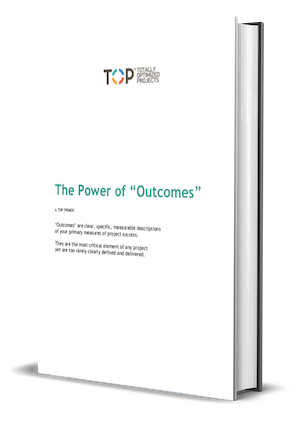Outcomes are clear, specific, measurable descriptions of what the future looks like, when it is working just right. Outcomes are (or should be) your primary measures of project success.
Most projects miss the vital step of clearly defining their ‘desired business outcomes’ – These describe what the future business-as-usual operational environment will look like when it is working just right. Instead, projects focus on what the project must do, rather than what the business intends to achieve. This omission undermines the ability of projects to deliver business value.
When you just get this one step right - of defining the 'desired business outcomes' for each and every project - it will single-handedly transform your ability to execute successfully, and increase the value you realize from your projects.
Your ‘desired business outcomes’ are the focal point around which everything else revolves. Clearly defining them ensures you are focused on success and that you will know it when you achieve it.
The orthodox project wisdom is that the business has “unrealistic expectations,” and to some extent, this statement is both right and wrong:
- It is right, in that the ‘outcomes’ the business needs and expects are not the same as the ‘outcomes’ that the project can deliver on its own. Therefore, if the business is expecting the project to deliver the final 'desired business outcomes' with little-to-no business involvement and support, it is going to be disappointed.
- Where this statement is wrong, is that the 'desired business outcomes' can be delivered, fully meeting business expectations if the business and project teams work effectively together. This means not just at the end of the project during the implementation phase, but throughout the whole project from idea initiation to value delivery.
It is perfectly possible for your projects to deliver valuable business results when you change the focus of projects. To achieve this, you need to start each project or program by defining your true ‘desired business outcomes’ (as outcome statements).
Once defined, your outcome statements become the focal point of your project. You will find that when you refocus your projects from orthodox project outputs, deliverables, and general objectives, to measurable business outcomes, that you’ll automatically increase the value delivered. This is because:
- Change activities are targeted at achieving the desired business outcomes and their business benefits rather than just finishing the project and software deliverables. The gap between what the project delivers and what is required to deliver the benefits and value is eliminated.
- Everyone knows the real desired business outcomes, so they won’t perceive delivery of the project as the end in itself, rather a step on the journey and so continue to work to achieve the business outcomes and their benefits in full.
- The project team and governance teams make different design decisions during the project knowing what the eventual business outcomes and measures of success are, rather than making decisions based on the project’s more limited scope definition and time/cost constraints.
- The number, nature and value of benefits are greater because those people accountable for benefits identification and realization have a clearer view of what the desired business end states and their benefits are.
Using the desired business outcomes approach with clients over three decades, we have seen increases of over 400% in the value of the benefits vis-à-vis the initial project value estimates.
For more information you can download a copy of our book:


